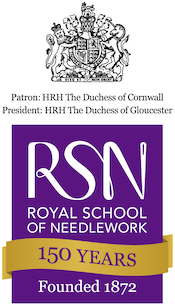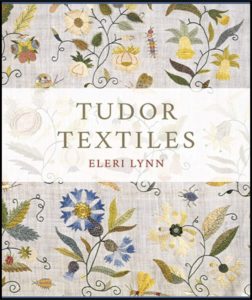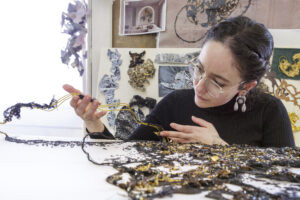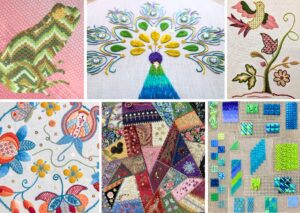We are delighted to introduce the exceptional work of RSN Third Year Degree students as they approach their graduation this June. Here’s a glimpse of their Major Projects, which will be on display at New Designers in London this July.
Beatriz Braga – “ALCHEMIA – The Design of Time”

ALCHEMIA – The Design of Time, is an art installation by hand embroiderer Beatriz Braga, inspired by how time can act as a designer through a series of alchemical processes and how this can contribute to a new understanding of what it means to design. By looking at processes like oxidisation, friction and sedimentation, Beatriz rethinks her own creative practice by including tarnished and worn materials.
Follow Beatriz on Instagram
Charlotte Farrant – “The Codification of Stitch”

The Codification of Stitch explores the intrinsic link between a person’s garment and how they are understood by society. The embellishment used within garments can dramatically alter how a garment is read, enabling the viewer to understand more. Inspired by Anne Lister’s coded diary writing and her own fascination with mechanics, Charlotte has developed a codification of embroidery stitches that can be directly translated into Lister’s coded diaries.
Follow Charlotte on Instagram
Clara Donald – “My Heritage”

Clara Donald’s latest collection draws inspiration from time spent in Scotland with her family, reflecting on both the striking beauty and the stark, unforgiving aspects of the Scottish landscape. One of her earliest influences was a detailed painting of a Scottish thistle in her grandfather’s home with the following inscription, ‘Thistle wild, proud and free, blooming where none dare to be.’ This sparked a deeper exploration of Scotland’s flora and fauna, a land where both of her grandfathers originate.
Follow Clara on Instagram
Gwyneth Melling – “Welcome to the Valley of the Tallest Waterfall – In the Tallest Waterfall’s Pool”

The Valley of the Tallest Waterfall manifests in our world as embroidered textile sculptures. Each creature is half life-sized, giving the viewer a window into this new fantasy world. Gwyneth’s practice hinges on imaginative storytelling, frequently aiming to question binary boundaries between ‘real’ and ‘imaginary’ through the creation of a new, embroidered environment to create tension between the conventionally-real world and the new world of her own.
Follow Gwyneth on Instagram
Izzy Ager – “Tracing Floral Journeys”

Tracing Floral Journeys explores the journeys and findings of botanical illustrators from the late 17th century up to the present day, such as Edith Holden and Catherine Hamilton. Both created diaries to document their journeys and everyday life, accompanied with an illustration of botany. Reflecting their processes, hand embroidery artist, Izzy Ager, explored the shapes and patterns of flora collected over her travels to historical places and gardens near her and in Surrey and its outskirts, to develop her ideas for this collection.
Follow Izzy on Instagram
Olaitan Onibuje – “Echoes of my Ancestors”

Echoes of my Ancestors is a collection of caps and canvas jackets inspired by streetwear, by hand embroiderer, Olaitan Onibuje. The main themes draw on her personal history, culture and heritage that have formed her identity.
This body of work highlights the importance of different cultures coming together to form someone’s identity. Growing up with two immigrant parents, Olaitan was raised with their Nigerian values as well as having her own, being brought up in Ireland and the UK. She shows her appreciation for her culture and her parents through the use of embroidery, her love of patterns and organic form, using traditional pre-colonial art as an inspiration.
Follow Olaitan on Instagram
Ruta Malik – “I See You: Noticing the Unnoticeable”

In the fast-moving world, everyone is rushing and it becomes more difficult to see commonplace things. The intricacies of the natural world often get dismissed and taken for granted. I See You: Noticing the Unnoticeable, hand embroiderer Ruta Malik’s most recent collection, is about appreciating the ordinary. It consists of two pieces – The Stone Cut in Half and Fragmented. This is the artist’s personal response to noticing the details in everyday life: sharing her feeling of awe in relation to simple objects and transforming them into tangible pieces of art.
Follow Ruta on Instagram
Would you like to see these pieces in person?
Come along to New Designers in London this July to see the Major Projects in detail, and to chat to our Degree Graduate Students about their work.
Follow the RSN Degree on Instagram
















